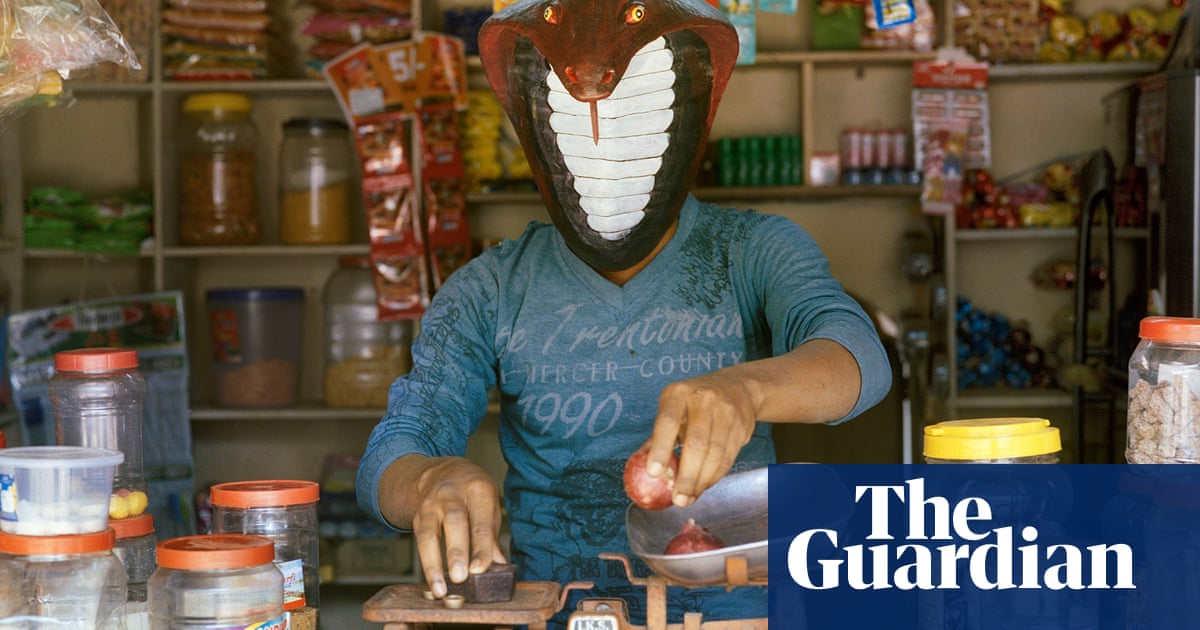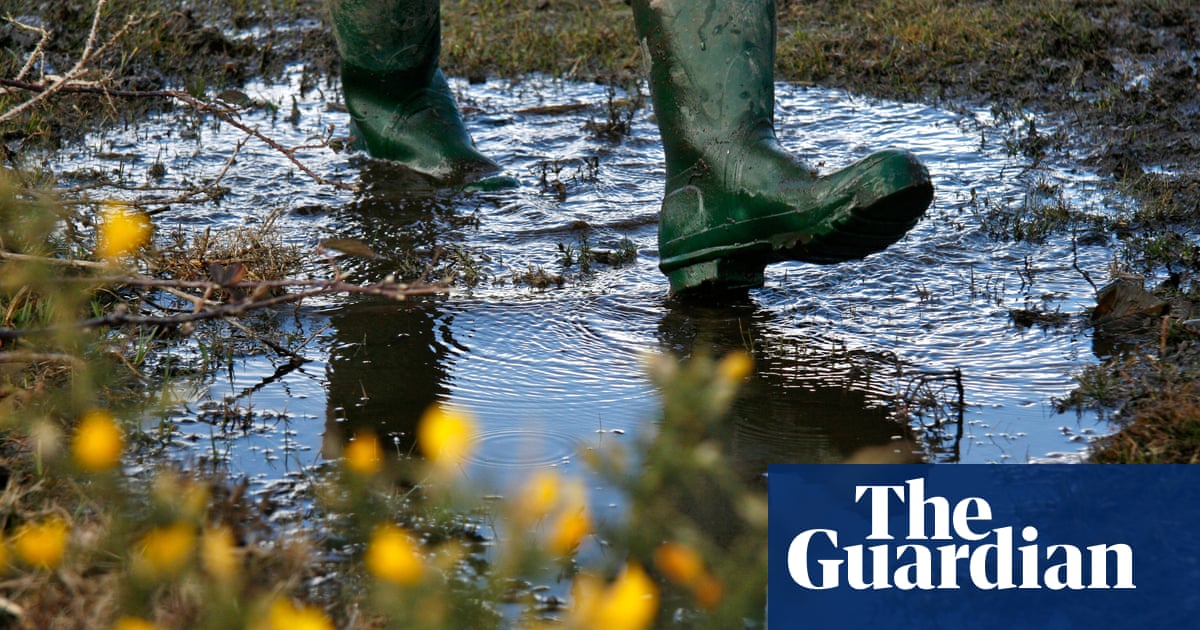
Gauri Gill started out in her 20s, a Delhi-based photojournalist covering stories right across India. She’d drop in, drop back out, then later find herself wondering what had happened to all the people she had photographed. “In India, as across the world,” says Gill, “the rural is being written out. The city – and AI is an extreme extension of the city – leads us to think we can do everything through machines. But the actual people on the ground – the farmers, the peasants, the Adivasis [the term given to India’s indigenous peoples], the forest-dwellers, who have lived so beautifully and so sustainably on the earth and from whom we should be learning – are being crushed.”
In 1999, Gill saw a young girl being beaten by her teacher at a school near Jodhpur and decided this was something she needed to spend longer on. She pitched a story on village schools. When no commission came, Gill quit her job at a magazine and made her way back to the farthest reaches of Rajasthan, to the Thar desert. She wanted to record what life there was like, especially for women and girls. She could not look away.
This marked the beginning of a photographic archive, now in its third decade, that Gill calls Notes from the Desert. For a long time, she showed the photographs only to the people in them, now her friends. She worried about “people with power going in and representing people without power”. But one day, she spoke to a great activist who had long worked in these areas. He said: “Don’t you think rich people have hearts?” Taking her work only to the relevant villages, he added, could not be as impactful as taking it farther afield, to Delhi and Mumbai, say. After all, the villagers already knew their stories.
In 2020, again, Gill could not look away when farmers from Punjab, Haryana, Uttar Pradesh and beyond – fearing the government’s agricultural reforms would further imperil their already fragile livelihoods by giving greater power to global corporations – travelled in convoys of tractors and trucks to protest in Delhi. They drove up to the police barricades on the roads leading into the capital and made camp. Did Gill grab her camera?
Actually, Gill’s archive does not document the year-long protest that followed. There were activists living there throughout, she says, who were doing an amazing job of getting the message out. Instead, she first visited in January, two months in, merely to show her support. It was freezing cold. There were neither proper toilets nor running water. Why is it, she wondered, that the voices of the people who are actually growing our food are not heard? So Gill chose to document the village the farmers built, especially the way they adapted their farm vehicles to make them habitable during extreme weather.
This series is called The Village on the Highway and it is one of the many pictorial treasures heralding the completion of the new Photography Centre at the V&A in London, which opens to the public on 25 May. Spread across seven galleries, the centre chronicles photography from its very beginnings to the present day, aiming to “explore its extensive impact on our lives”.
Gill works with a big film camera. It is a slow, almost painterly medium that lends itself to capturing margins and details, things quiet and overlooked. The farmers had brought flags, produce, patience and the sort of resolve that comes from a lifetime of working fields. They had also brought their own knowledge systems and skills – including the make-do ethos called jugaad. They stretched out tarpaulin and trussed it up to metal, taped mesh to door frames and erected tents and bamboo scaffolding, to carve out spaces to eat and rest in. For all their endeavours, though, the people are absent from these shots, which just feature what Gill calls these “speaking structures”.
The villagers also set up kitchens boasting brick-cased fires and cooking pots the size of bathtubs, from which they fed not just each other but also the people – some of the city’s poorest – already living where they now camped. Gill photographed cauliflower plants one farmer had planted in the roadside dirt. “We will grow produce right here and show them!” he told her. Twelve months later, as the laws were finally repealed and the farmers started packing up to go home, Gill watched a local woman cry. She had come to the site to be fed every day.
“In the face of extreme hard-heartedness, the farmers were saying, ‘Here we will give you food. We will be generous.’ That spirit and quality is what moved me. When you were there with them, you didn’t feel like leaving. Even at the very low points, people would say, ‘It’s OK, we will win, we will just keep sitting here.’ It was so optimistic.” Many of the farmers were elderly men, who as Gill puts it, “brought their bodies” to the year-long struggle. Some estimates put the number of those who died as a result at 750. “One man said to me, ‘If you want to see Guru Nanak [the 15th-century founder of Sikhism] come and see the old men over here.’ It would break my heart because they were in the last stages of sitting there, giving themselves, fighting not just for themselves but for all of us. Their survival is key to all of us.”
Scroll through The Village on the Highway section of Gill’s archive and it’s the details that capture the eye: Buddhist prayer flags, red Communist flags, the Indian national flag, Sikh religious flags, farmers’ association flags. Then there are the garlands of plastic flowers, the rusting corrugated iron sheets jostling with unhitched trailers and large water tanks. Straw is stuffed beneath tarpaulin-covered roofs, for extra insulation against cold air and monsoon rains. Shoes, flicked off tired feet, mark the entrance to a living space decorated with muddy rugs. Gill calls the site “an architecture of resistance and tremendous beauty, because you see how it comes from urgent necessity”.
This combination of resistance and beauty can be found in another ongoing series, Traces. Begun in 1999, it records the graves created in the Thar desert by Muslims, Hindus, nomadic Jogis and Bishnoi alike. To an outsider, these slight mounds, subtly signalled by a grouping of stones or crockery shards, might appear merely incidental to the rocky terrain. But the people who live there know – and, crucially, Gill knows the people.
When Gill talks about her projects, she says “we”. So does she work with a big team? “No,” she replies. “I’m alone, pretty much.” In Delhi, she has a studio manager to help with admin, but when she’s working elsewhere, it’s just her and her camera and the people she’s visiting. She speaks with them in Hindi, Punjabi, English and Hindustani (the lingua franca that mixes Urdu and Hindi). Mostly, though she tries to get out of the way and listen.
People might ask her to go to the police station with them when they’re in trouble, or accompany them to the hospital if doctors aren’t taking them seriously. As an English-speaker, says the photographer, she has a power people can tap into. “The world of English,” she says, “is the world that is seen to be the centre, the norm. But there are many, many, many other worlds.”
In Acts of Appearance, begun in 2015, Gill collaborated with papier-mache artists in a village in Maharashtra. For the annual Bohada festival, sculptors from the Adivasi communities of the Kokna and Warli tribes create extraordinary lacquered masks depicting the deities, which the villagers wear in re-enactments of myths that last several nights. Struck by how removed such a visual universe was from the day-to-day challenges the people face, she commissioned the artists to make masks of the animals and objects they treasured most, then photographed everyone wearing them.
The result is extraordinary, like a people’s mythology. Animals are a natural and symbiotic part of the Adivasi universe. We see two women, one a clock face, the other a lizard, peering out of a bashed white transit van. Elsewhere, three people with the heads of a camel, a donkey and a goat sit cross-legged at a carrom board. A hare-headed girl crouches in a cotton tent. Although no glimpse is given of the people behind the masks, Gill feels very much in their debt. “You see the name Gauri Gill on these works,” says the photographer, “but so many other people make them possible.”
Gill loves how the mask series has taken on a life of its own. She recently stood in the Louisiana Museum of Modern Art, during a major retrospective of her work, marvelling at the conviction with which some visitors, not knowing who she was, were explaining her photographs to others. With a laugh, she says: “They really seemed to own the work!”
The V&A Photography Centre opens on 25 May












